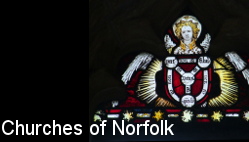
home I index I latest I glossary I introductions I e-mail I about this site
St Thomas, Foxley
Follow these journeys as they happen at Last Of England Twitter.
St Thomas, Foxley The village of Foxley is unfortunately bisected by the busy Norwich to Fakenham road, but a short distance to the north of that road the heart of the old village is idyllic, with flinty cottages and the church on a rise above the street. Its position makes it appear more imposing than you might expect for such a small church. As seems to be common in this area, the church is mostly a work of the late 13th Century becoming the early 14th Century, the tower presumably topped out towards the end of the medieval period. The elegant south porch seems well suited for the conduct of parish business, and you step through it directly into the west end of a charming interior. There is no coloured glass in the nave, and the intimacy is accentuated by a low ceiling and a west gallery. Under the gallery is a substantial early 14th Century font which must have come with the rebuilding. It really does feel shoe-horned in. The view to the east is through 17th Century benches and box pews set on old brick floors, towards a contemporary double-decker pulpit and Foxley's elegant little screen, erected by a bequest of 1472. This is as simple and understated as the church itself. It has been substantially restored, but the gates contain the original painted panels with figures of the four Latin Doctors. St Ambrose and St Gregory are on the north gate, St Jerome and St Augustine are on the south gate. St Ambrose wears a mitre, while St Gregory wears a papal crown, a dove whispering in his ear. St Jerome wears his cardinal's robes and hat, and appears to be holding an open music score. St Augustine wears a mitre and holds a processional cross. At the feet of St Jerome and St Augustine are two kneeling figures, Agnes and John Baymont, the donors of the screen. They hold banners asking for prayers for their souls. And there is something
else, which you might miss unless you look for it. The
upper part of the screen appears to have been sawn off at
some point, and then re-attached. Mortlock observed that
the cutting down was done during the furious vandalism of
images promoted by the boy King Edward VI in the late
1540s, and that the repair came the following decade
under Queen Mary. There's a similar suggestion in Medieval
Rood Screens of the Southern Marches which notes
that the rood-screen at Foxley, Norfolk, cut down to
the wainscot during the reign of Edward VI, had its upper
half reinstated during the reign of Mary. The screen
still stands today, the metal strap plates fastening the
standards back together clearly visible. Simon Knott, September 2022 Follow these journeys as they happen at Last Of England Twitter. |
|
|||||||||||||||||||||||||||||||||||||||||||||||||||||||
home I index I latest I introductions I e-mail I about
this site I glossary
Norwich I ruined churches I desktop backgrounds I round tower churches
links I small
print I www.simonknott.co.uk I www.suffolkchurches.co.uk